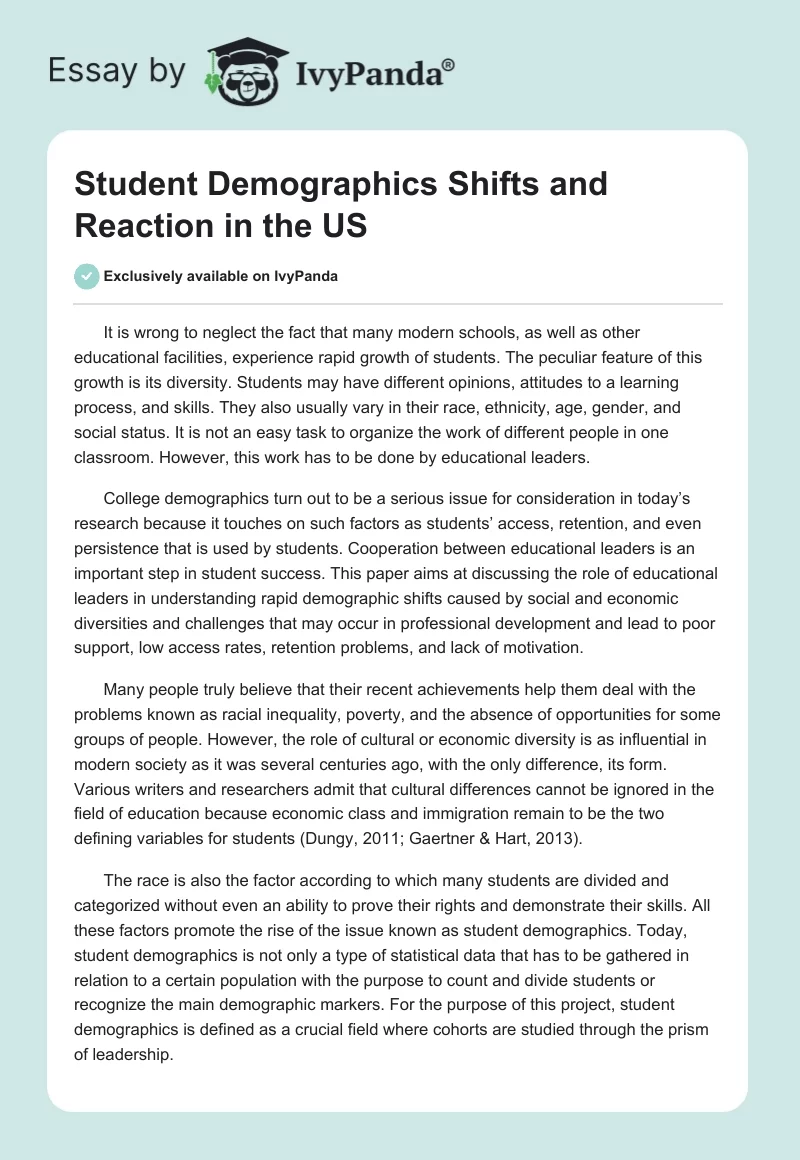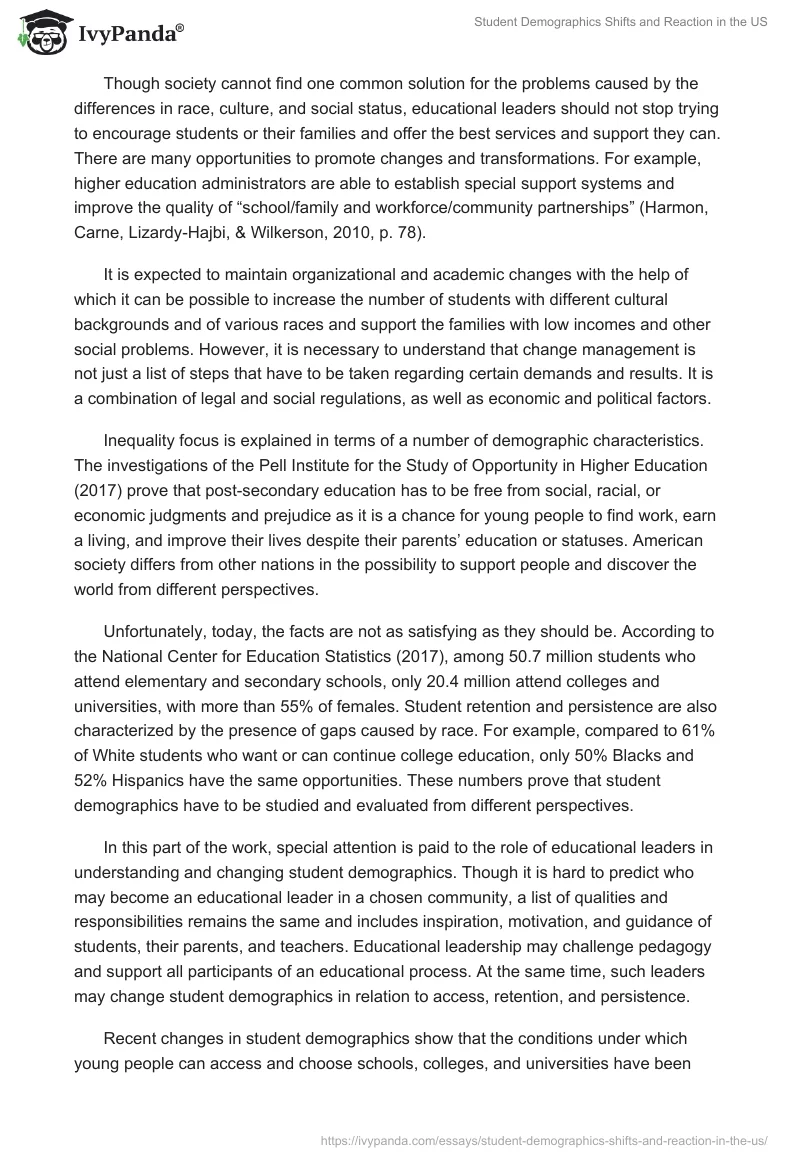It is wrong to neglect the fact that many modern schools, as well as other educational facilities, experience rapid growth of students. The peculiar feature of this growth is its diversity. Students may have different opinions, attitudes to a learning process, and skills. They also usually vary in their race, ethnicity, age, gender, and social status. It is not an easy task to organize the work of different people in one classroom. However, this work has to be done by educational leaders.
College demographics turn out to be a serious issue for consideration in today’s research because it touches on such factors as students’ access, retention, and even persistence that is used by students. Cooperation between educational leaders is an important step in student success. This paper aims at discussing the role of educational leaders in understanding rapid demographic shifts caused by social and economic diversities and challenges that may occur in professional development and lead to poor support, low access rates, retention problems, and lack of motivation.
Many people truly believe that their recent achievements help them deal with the problems known as racial inequality, poverty, and the absence of opportunities for some groups of people. However, the role of cultural or economic diversity is as influential in modern society as it was several centuries ago, with the only difference, its form. Various writers and researchers admit that cultural differences cannot be ignored in the field of education because economic class and immigration remain to be the two defining variables for students (Dungy, 2011; Gaertner & Hart, 2013).
The race is also the factor according to which many students are divided and categorized without even an ability to prove their rights and demonstrate their skills. All these factors promote the rise of the issue known as student demographics. Today, student demographics is not only a type of statistical data that has to be gathered in relation to a certain population with the purpose to count and divide students or recognize the main demographic markers. For the purpose of this project, student demographics is defined as a crucial field where cohorts are studied through the prism of leadership.
Though society cannot find one common solution for the problems caused by the differences in race, culture, and social status, educational leaders should not stop trying to encourage students or their families and offer the best services and support they can. There are many opportunities to promote changes and transformations. For example, higher education administrators are able to establish special support systems and improve the quality of “school/family and workforce/community partnerships” (Harmon, Carne, Lizardy-Hajbi, & Wilkerson, 2010, p. 78).
It is expected to maintain organizational and academic changes with the help of which it can be possible to increase the number of students with different cultural backgrounds and of various races and support the families with low incomes and other social problems. However, it is necessary to understand that change management is not just a list of steps that have to be taken regarding certain demands and results. It is a combination of legal and social regulations, as well as economic and political factors.
Inequality focus is explained in terms of a number of demographic characteristics. The investigations of the Pell Institute for the Study of Opportunity in Higher Education (2017) prove that post-secondary education has to be free from social, racial, or economic judgments and prejudice as it is a chance for young people to find work, earn a living, and improve their lives despite their parents’ education or statuses. American society differs from other nations in the possibility to support people and discover the world from different perspectives.
Unfortunately, today, the facts are not as satisfying as they should be. According to the National Center for Education Statistics (2017), among 50.7 million students who attend elementary and secondary schools, only 20.4 million attend colleges and universities, with more than 55% of females. Student retention and persistence are also characterized by the presence of gaps caused by race. For example, compared to 61% of White students who want or can continue college education, only 50% Blacks and 52% Hispanics have the same opportunities. These numbers prove that student demographics have to be studied and evaluated from different perspectives.
In this part of the work, special attention is paid to the role of educational leaders in understanding and changing student demographics. Though it is hard to predict who may become an educational leader in a chosen community, a list of qualities and responsibilities remains the same and includes inspiration, motivation, and guidance of students, their parents, and teachers. Educational leadership may challenge pedagogy and support all participants of an educational process. At the same time, such leaders may change student demographics in relation to access, retention, and persistence.
Recent changes in student demographics show that the conditions under which young people can access and choose schools, colleges, and universities have been considerably improved. Gaertner and Hart (2013) explain access to higher education as “a benefit that should be available to those who have overcome significant hardship” through the promotion of policies to “enhance equal opportunity and access” (p. 373). Educational leaders should focus on the creation of new programs and rules in regard to which race or social status of students does not play an integral role.
However, it is not enough for a leader to invite a student and give some guarantees that all academic opportunities must be used. A leader has to think about how to make a student stay and develop their academic and social skills. Retention and persistence of students have to be promoted by leaders despite the race or other demographic factors of students. No Child Left Behind is one of the main acts that define the scope of leaders’ work, but it is not the only document.
Leaders are able to develop their own approaches to cooperation with children, interview students and their families, and clarify the problems that bother them from the point of view of their academic achievements and peer relationships. The level of persistence depends on how well students learn the material, have access to resources, and use the opportunity to show their achievements. Leaders are responsible for the provision of equal opportunities. Therefore, they have to remove all possible racial or social prejudices from their settings and underline the role of education and knowledge instead of the color of skin or paying capacity.
In general, despite the dependence of educational leaders on the local government and the presence or absence of laws and legislation, student demographics and its relation to access retention and persistence is the problem that they can solve. The promotion of support, recognition of current problems, and evaluation of possible improvements are the tasks that leaders can complete in their educational careers each day. As soon as an educational leader believes that race, social status, or age should not play a role in their academic facilities, student demographics stop being a problem.
References
Dungy, G. J. (2011). A national perspective: Testing our assumptions about generational cohorts. In F. A. Bonner, II, A. F. Marbley, & M. F. Howard-Hamilton (Eds.), Diverse millennial students in college: Implications for faculty and student affairs (pp. 5-24). Sterling, VA: Stylus Publishing.
Gaertner, M. N., & Hart, M. (2013). Considering class: College access and diversity. Harvard Law & Policy Review, 7(2), 367-403.
Harmon, C., Carne, G., Lizardy-Hajbi, K., & Wilkerson, E. (2010). Access to higher education for undocumented students: “Outlaws” of social justice, equity, and equality. Journal of Praxis and Multicultural Education, 5(1), 67-82.
National Center for Education Statistics. (2017). Fast facts: Back to school statistics. Web.
The Pell Institute for the Study of Opportunity in Higher Education. (2017). Indicators of higher education equity in the United States. Web.


